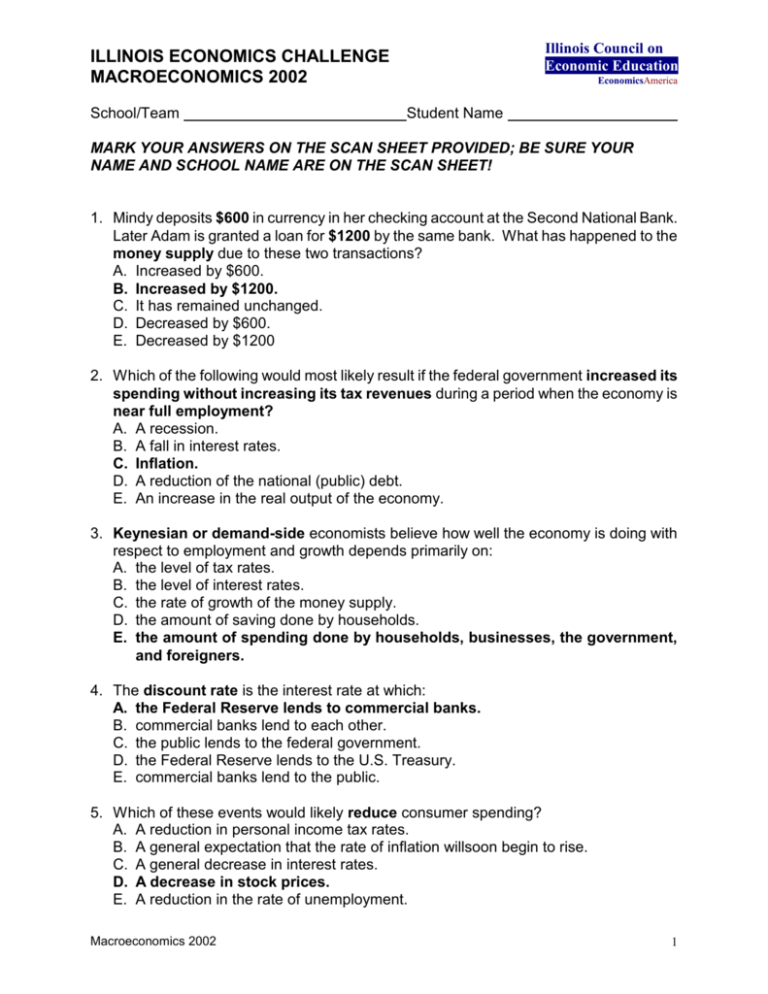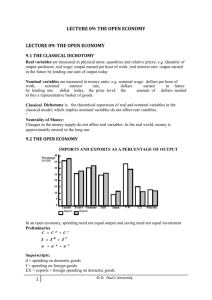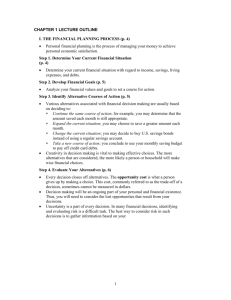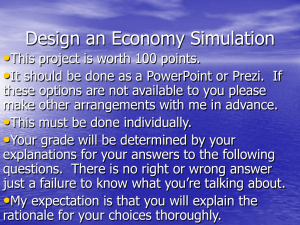illinois economics challenge - UIC Center for Economic Education
advertisement

Illinois Council on Economic Education ILLINOIS ECONOMICS CHALLENGE MACROECONOMICS 2002 School/Team EconomicsAmerica Student Name MARK YOUR ANSWERS ON THE SCAN SHEET PROVIDED; BE SURE YOUR NAME AND SCHOOL NAME ARE ON THE SCAN SHEET! 1. Mindy deposits $600 in currency in her checking account at the Second National Bank. Later Adam is granted a loan for $1200 by the same bank. What has happened to the money supply due to these two transactions? A. Increased by $600. B. Increased by $1200. C. It has remained unchanged. D. Decreased by $600. E. Decreased by $1200 2. Which of the following would most likely result if the federal government increased its spending without increasing its tax revenues during a period when the economy is near full employment? A. A recession. B. A fall in interest rates. C. Inflation. D. A reduction of the national (public) debt. E. An increase in the real output of the economy. 3. Keynesian or demand-side economists believe how well the economy is doing with respect to employment and growth depends primarily on: A. the level of tax rates. B. the level of interest rates. C. the rate of growth of the money supply. D. the amount of saving done by households. E. the amount of spending done by households, businesses, the government, and foreigners. 4. The discount rate is the interest rate at which: A. the Federal Reserve lends to commercial banks. B. commercial banks lend to each other. C. the public lends to the federal government. D. the Federal Reserve lends to the U.S. Treasury. E. commercial banks lend to the public. 5. Which of these events would likely reduce consumer spending? A. A reduction in personal income tax rates. B. A general expectation that the rate of inflation willsoon begin to rise. C. A general decrease in interest rates. D. A decrease in stock prices. E. A reduction in the rate of unemployment. Macroeconomics 2002 1 6. Demand-side economists argue that a policy of balancing the federal budget every year: A. is the best economic policy the government could pursue. B. tends to be pro-cyclical, that is, makes recessions worse and expansions inflationary. C. tends to be counter-cyclical, that is, makes recessions less severe and expansions less inflationary. D. is preferable to running surpluses but not as good as running deficits. E. is never desirable. 7. If the rate of growth in an economy is 2 percent, inflation is 3 percent, and the nominal rate of interest is 10 percent, what is the real rate of interest? A. 5% B. 8% C. 12% D. 7% E. 13% 8. When the government uses policies intended to increase total spending (or aggregate demand) in order to reduce unemployment, a possible "by-product" result is: A. A lower level of total output in the economy. B. A higher price level (that is, inflation). C. A fall in aggregate supply. D. Lower nominal rates of interest. E. A recession. 9. Increasing taxes generally: A. Reduces both household saving and spending. B. Reduces household spending but leaves saving pretty much the same. C. Reduces household saving but leaves spending pretty much the same. D. Increases household saving while it reduces spending. E. Increases both household saving and spending. 10. Which of the following statements about investment is true? A. Increases in the rate of interest tend to stimulate investment. B. Investment tends to be higher than usual in recession periods and lower than usual during expansionary periods. C. Investment tends to be the most volatile component of total spending in that the ratio of investment to GDP can vary greatly from one year to the next. D. The major component of investment spending is household purchases of corporate stocks and bonds. E. Investment is the largest single component of total spending. 11. The Federal Reserve controls the money supply primarily by: A. Controlling the amount of Federal Reserve Notes (that is, currency or paper money) in circulation. B. Altering the reserve position of banks through sales and purchases of government securities. C. Altering the required reserve ratio to control banks' ability to grant loans. D. Controlling the production of coins at the U.S. Mint. E. Buying and selling gold in international markets. 12. According to Keynesian theory, which combination of policies below is consistent (that is, the policies would tend to reinforce instead of offset each other)? Macroeconomics 2002 2 A. B. C. D. E. Decrease taxes; increase government spending; increase the money supply. Decrease taxes; decrease government spending; increase the money supply. Decrease taxes; increase government spending; decrease the money supply. Increase taxes; increase government spending; increase the money supply. Increase taxes; decrease government spending; increase the money supply. 13. Which of the following would not be included in this year's GDP figure? A. Kansas farmers sell a million bushels of wheat to South Africa. B. A barber purchases a cash register for use in his shop. C. A school district constructs a new high school. D. A museum purchases a Rembrandt painting for its collection. E. You pay $50 for two tickets to a *NSYNC concert. 14. Classical economists believed that if the velocity ("turn-over rate") of money was constant, a 10-percent increase in the money supply would ultimately increase: A. real output by 10%. B. employment by 10%. C. the price level by 10%. D. aggregate spending by 10%. E. the real interest rate by 10%. 15. Generally the federal government finances a budget deficit by: A. reducing the national debt. B. increasing the money supply. C. issuing common stock. D. selling bonds. E. borrowing from other countries. 16. Monetarists believe: A. fluctuations in the business cycle are the result of changes in the rate of growth of the money supply. B. inflation primarily results from the monopolistic pricing tactics of large corporations. C. the Federal Reserve should pursue policies which keep the rate of interest stable. D. the federal government's taxation policies have the largest impact on the performance of the economy. E. all transactions should be made in cash only (that is, no checks or credit cards should be allowed). 17. A primary reason for the creation of the FDIC was to: A. prevent excessive borrowing by the government from private financial institutions. B. establish lenders of last resort for financial institutions. C. enable the Federal Reserve to control the money supply. D. prevent "bank runs" (panic withdrawing of funds by depositors). E. deregulate the financial industry. Macroeconomics 2002 3 18. Which of the following is a contractionary economic policy? A. the selling of securities by the Federal Reserve. B. reductions in corporate and personal income taxes. C. increases in the size of the federal budget deficit. D. reductions in interest rates. E. increased rate of growth of the money supply. 19. Which of the following is a transfer payment? A. Payment of sales taxes at the grocery store. B. Cash payments to a babysitter. C. Payment for 100 shares of IBM stocks. D. Unemployment compensation paid to a laid-off worker. E. Payment by the government for Patriot missiles. 20. Growth in output per worker (labor productivity) of Western nations has been due to all the following except: A. growth in the quantity of capital. B. technological advance (growth in the quality of capital). C. growth in the quantity of the labor force. D. education and training of the labor force. E. the discovery of new ways to utilize various natural resources. 21. Which of the following would be counted as "unemployed" in the official unemployment statistics? A. An economist who drives a bus for a living. B. A painter who can't find work because more people are doing their own painting. C. A person who prefers to stay at home and raise their family. D. A substitute teacher trying to find a full-time position. E. A steelworker who, after looking for a job for six months, finally just gives up looking. 22. In the United States the majority of the money supply is backed by: A. gold, but not silver. B. silver, but not gold. C. both gold and silver. D. government securities. E. none of the above. 23. Which of the following is not considered to be investment as the term is used by economists? A. The piling up of inventories on a grocer's shelf. B. The purchase of a drill press by Ajax Manufacturing Co. C. The purchase of 100 shares of AT&T by your family. D. The construction of a housing complex. E. The building of a nursery school. Macroeconomics 2002 4 24. Assuming a reserve requirement of 10%, how much additional money can the bank represented below create? (All figures are in millions.) Assets Reserves Securities Loans Property A. None. $ 10 40 30 10 B. $2 Liabilities Demand Deposits Owner Equity C. $5 $80 10 D. $10 E. $20 25. The largest component of GDP (Gross Domestic Product) is: A. government purchases of goods and services. B. business purchases of capital goods. C. foreign purchases of U.S. exports. D. consumer purchases of goods and services. E. gross private domestic investment. 26. If people believe the economy is strong, they are likely to: A. begin saving because they have more money than they need to spend. B. begin saving because they fear the good times will not last. C. spend money and use credit because they fear that inflation will soon be high. D. spend money and use credit because they are more secure and confident about their economic situation. E. pay-off past debts and avoid new debt. 27. Who is most likely to be harmed by unanticipated inflation? A. people or businesses which borrow money. B. governments which have a progressive personal income tax. C. workers with COLA clauses in their employment contracts. D. lenders or creditors. E. everybody fairly equally. 28. Which of the following would tend to slow the growth of productivity in an economy? A. greater capital investment. B. higher rate of saving. C. higher rate of technical progress. D. greater amount of business regulation. E. lower rate of taxation. 29. If interest rates rise, what is likely to happen to the prices of stocks and bonds? Stock Prices Bond Prices A. fall rise B. fall fall C. rise fall D. rise rise E. rise stay the same 30. Which of the following is an example of structural unemployment? A. B. C. D. E. a computer programmer who quits her job to search for one in a warmer climate. a construction worker who loses his job in the winter. a mine worker who loses his job during a recession. an economics teacher who decides to retire early. a bank teller who is replaced by an ATM machine. Macroeconomics 2002 5







